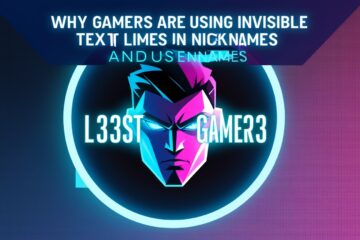Why People Are Using Invisible Text for Privacy
As a digital project manager with over 10 years of experience, I’ve seen many tools for keeping information safe. One of the most surprising is invisible text. People now use it to share private messages, personal data, or even hidden notes without anyone knowing. It’s simple, smart, and more useful than most think.
Invisible text is made of special characters you can’t see. It doesn’t show up unless you copy and paste it or look closely in the code. You can create it using an invisible text generator and send it in messages or posts without raising suspicion. Privacy lovers are using it to avoid filters, hide content from bots, or just keep data quiet in plain sight.
How Invisible Characters Work to Hide Sensitive Content
Invisible text uses Unicode characters like U+200B (zero-width space) or U+2063 (invisible separator). These don’t create any visible marks, but they are still there. Most people won’t even notice they’re reading or clicking on something with hidden code inside.
I once worked with a client in finance who had to send sensitive stock tips without alerting company firewalls. We used invisible characters between the words. It looked like a normal email, but only the people with our decoder knew what it meant. This was a legal workaround that didn’t involve risky attachments or links.
You can find more about these characters at Unicode’s official chart. There are dozens of invisible characters, and many tools online allow you to copy them quickly.
Top Use Cases: Invisible Text in Real Life
Let’s look at how different people use invisible text today to share secure or private data:
| Group | Use Case | Tool or Platform |
| Gamers | Hide names or bypass filters | Roblox, Fortnite |
| Students | Share secret notes in school docs | Google Docs |
| Professionals | Send quiet data for team use | Email, Slack |
| Activists | Avoid censorship or tracking | Twitter, Telegram |
| Writers | Add invisible copyright marks | PDFs, blogs |
When working on a marketing campaign, I added invisible tracking tags in online surveys. These helped us understand which users clicked what, without showing any obvious tracking code. This invisible approach gave us cleaner data and better security.
Sharing Private Data Without Getting Noticed
Sending private data is tricky. Most systems scan for keywords, links, or sensitive terms. Invisible text lets you break up those signals so machines don’t flag it. You can also hide sensitive details in plain sight.
Let’s say you want to share a phone number but don’t want platforms like Facebook to auto-link or scan it. Instead of 123-456-7890, you can add invisible spaces between the digits. The person reading can still figure it out, but bots won’t grab it.
This trick is also used by journalists in countries with tight censorship. Instead of sharing risky phrases, they type with invisible separators. This fools word scanners. The Electronic Frontier Foundation supports tools that promote this kind of digital safety.
Invisible Text for Private Messaging and Codes

One of the most creative uses I’ve seen is in encrypted group chats. A client in crypto trading used invisible characters as secret codes. Each team member had a guide to decode the messages. For example, one invisible mark meant “Sell” and another meant “Buy.”
Apps like Telegram and Signal already offer end-to-end encryption, but adding invisible text gives an extra layer. It makes the message unreadable even if someone screenshots it or copies it elsewhere.
You can also use this method to verify content. If you hide your name or ID in an article, only those with the decoder will know it’s really yours. Some people also use invisible text for personal reminders or time stamps.
When Invisible Text Helps You Stay Hidden on Social Media
Social media platforms often scan text to block certain topics, links, or language. Invisible characters help break those rules without looking suspicious. This is useful when you’re talking about sensitive topics like politics, privacy, or banned words.
A friend once posted about a new data leak but used invisible breaks in the names to avoid being shadowbanned. His message reached more people than others who used regular words. That’s when I realized how invisible text isn’t just for hackers—it’s a real privacy tool for everyone.
Some users even include invisible comments in Instagram or TikTok captions to avoid filters. You can test it yourself by adding invisible characters using Empty Character, which many influencers use to beat platform rules.
Safety Tips When Using Invisible Text for Online Privacy
While invisible text is helpful, it also comes with risks. If used wrongly, it can confuse readers or trigger spam filters. I remember when one of my coworkers used invisible characters to format a LinkedIn post, but it ended up breaking the layout. It looked empty, and no one engaged with it.
If you’re sharing private information, make sure the other person knows how to decode it. Use a simple guide or tell them beforehand. Always test your message before sending it to a group or on public platforms.
Also, don’t use invisible text for illegal or harmful purposes. Many privacy tools like ProtonMail promote safe and ethical privacy practices. Invisible text is not a free pass to do shady things. Use it smartly and with respect.
How to Create Invisible Text Without Coding Skills
You don’t need to be a coder or hacker to use invisible text. Anyone can do it with simple copy-paste tools. For example, I often use the Zero Width Text Generator when I want to add hidden notes in shared documents.
Here’s how to do it:
- Go to a free invisible text generator online
- Type any word or letter
- Copy the result (it may look blank)
- Paste it between your words or in hidden places
You can also make your own hidden patterns. For example, placing an invisible character after every third letter in a message can be your secret code. Just make sure your team understands it, or you may confuse your readers.
Common Mistakes to Avoid When Hiding Information Online
Even smart people can mess up when using invisible text. One big mistake I’ve seen is overusing it. If your message is too hidden, it might get flagged as spam or fake. Platforms like Gmail or Discord may block or delete it.
Another issue is sharing private data in a public space. Just because it’s invisible doesn’t mean it’s safe. If someone copies your post, they can see the hidden message too. Don’t rely on it for passwords or banking info. Use password managers for that.
When I used invisible characters in a Google Sheet once, a teammate accidentally deleted them without realizing. Our hidden notes were lost, and we had to redo the work. So always back up your secret codes or use a key others can access.
Comparing Invisible Text to Other Privacy Tools
How does invisible text compare with other privacy tools? Let’s see in this simple table:

| Privacy Tool | Use | Skill Level | Visible? | Risk |
| Invisible Text | Hide info in plain sight | Easy | No | Low to Medium |
| VPN | Hide location and traffic | Medium | No | Low |
| Password Manager | Store sensitive logins | Easy | No | Low |
| Encrypted Email | Send secure messages | Medium | No | Low |
| Steganography | Hide data in images/files | Advanced | No | Medium |
As a manager, I usually pair invisible text with secure email or file-sharing apps like Tresorit. That way, even if one layer fails, the other keeps the data safe.
When Not to Use Invisible Text for Private Sharing
Invisible text isn’t perfect for everything. Don’t use it for legal documents, customer data, or anything that must be fully visible. Many companies and schools have policies that block hidden content.
Also, if you work in industries like healthcare or finance, you may be breaking compliance rules by hiding info, even for privacy reasons. Always check your company’s policies first.
For basic personal use, like sending a joke or secret code to a friend, invisible text is fun and safe. But for bigger things, use secure tools and encryption too.
Final Thoughts From a Digital Manager
Invisible text has helped me in unexpected ways. From sending secret team instructions to testing filters on platforms like Instagram, I’ve learned that this simple trick can do a lot when used right. It gives you privacy, creativity, and control—without needing expensive software or expert help.
But with great privacy comes great responsibility. Use invisible text to protect your info, not to trick or hurt others. Test what works best for your platform, and always keep a backup plan.
If you’re curious, try an invisible text tool today and send a secret message to a friend or co-worker. It’s a fun and practical way to take control of your digital privacy.



